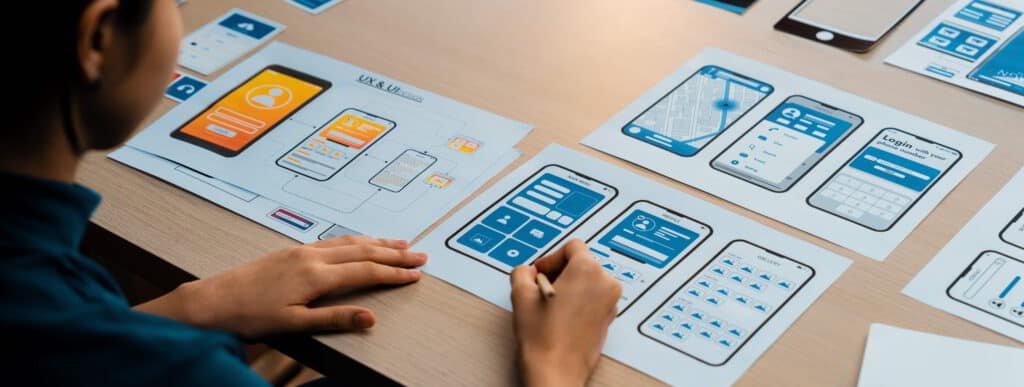9 Essential Tips to Avoid Costly Mistakes in the Mobile App Development Process!
Creating a mobile app has several steps. First, you start with ideas and research the market.
Then, you move on to design, coding, testing, and finally, deployment. A good plan leads to a high-quality, user-friendly app.
It stays on budget and meets business goals.
App developers need a simple plan to succeed. A clear roadmap helps use resources well, avoid delays, and improve user experience.
Following easy steps makes development smooth and keeps users happy.
This guide shares 9 key tips to excel in mobile app development in 2025. Use these ideas to make your app shine in a crowded market.
#1 Understanding the Mobile App Development Process
To develop a successful mobile app, you need to understand each stage of the process clearly. Each phase is important and affects the next one. So, a structured approach is key for efficiency and success.
The key stages of mobile app development include:
– Strategy Development – Defining goals, target audience, and business objectives.
– Analysis and Planning – Conducting market research and outlining project requirements.
– Mobile UX/UI Design – Creating user-friendly and visually appealing interfaces.
– Development – Writing clean, efficient code for functionality and performance.
– Testing and Quality assurance – Identifying and fixing issues before launch.
– Deployment – Releasing the app on AppStore or internal platforms.
– Support and Performance – Ensuring long-term app stability and updates.
By following simple steps, businesses can make smart choices, save time, and use resources wisely. A clear process helps create a high-quality, successful app.
#2 Setting Clear Goals for Mobile App Development Success

Clear goals are key to a successful mobile app development process. Clear goals define the app’s purpose. They make development smoother and keep it aligned with business needs.
To create a strong development roadmap, ask these key questions:
- What is the app’s primary goal?
- What essential features should we include?
- Which features can we add later?
- Who is the target audience?
Answering these questions builds a strategic plan. It ensures the app meets user needs and business goals.
Additionally, goal-setting should be a collaborative effort. Involving designers, developers, marketers, and potential users creates a balanced approach. This synergy leads teams to better decisions. It increases the chances of success after launch.
Setting clear goals from the start helps teams stay focused. This way, they can use their resources better. As a result, they create a mobile app that shines in a crowded market.
#3 Choosing the Right Tech Stack for Mobile Apps
The technology stack you pick is vital. It affects your mobile app easy to expand functionality, and performance. Choosing the right tools makes development easier. It boosts user experience and helps future growth.
Here are key factors to consider when choosing a mobile app technology stack:
- App requirements
Define the app’s features, complexity, and target platforms. - Development team skills
Pick technologies your team knows well for smooth development. - Easy to expand
Select a stack that allows for future feature expansion and user growth. - Performance
Ensure the chosen stack delivers high-speed, seamless functionality. - Boost security and functionality by adding new technologies.
Think about using machine learning, artificial intelligence, and blockchain in your mobile app.
- App requirements
Popular Technology Stacks for Mobile App Development
Picking the right tech stack helps your app perform well, scale, and stay relevant. This choice sets you up for lasting success.
- iOS: Swift, React Native, Flutter
- Android: Kotlin, React Native, Flutter
#4 Putting UX First in the Mobile App Development Process

User experience (UX) is a key factor in mobile app success. A well-designed UX keeps users engaged, while a poor experience drives them away. Research shows that 88% of users won’t come back after a bad experience. About 79% of U.S. mobile users are likely to return and share a site if it is easy to use.
Why UX Should Come First
To create an app that attracts and retains users, focus on:
– Understanding user needs – Conduct research to identify pain points and expectations.
– Simple and intuitive design – Ensure easy navigation and a clutter-free interface.
– Optimized load times – Speed is critical for engagement and retention.
– Value-driven experience –A great UX looks good, but it also needs to work well and be easy to use.
Focusing on UX design helps mobile apps boost user satisfaction. This also improves retention and broadens their audience. As a result, apps can achieve long-term success.
#5 Agile Methodologies in the Mobile App Development Process
Using Agile for app development makes work easier and more flexible. Teams can make changes anytime, ensuring a high-quality app that meets user needs.
Why Use Agile in Mobile App Development?
- Iterative development – We design, develop, test, and improve apps in short cycles.
- Faster releases – Frequent updates ensure continuous enhancements.
- Improved collaboration –Developers, testers, and stakeholders work together efficiently.
- Agile keeps the app aligned with user needs, ensuring a user-focused approach.
Agile methods help development teams build scalable and high-quality mobile apps. These apps can quickly adapt to changing needs without sacrificing speed.
#6 Rigorous Testing in the Mobile App Development Process
Testing is important to make sure your app works well. It helps with performance, features, and security. A well-tested app runs smoothly and keeps users happy. These factors are vital for app success.
Key Stages of Mobile App Testing
- Unit Testing – Tests each component individually to ensure proper functionality.
- Integration Testing –Evaluates how different components work together within the app.
- Performance Testing – Measures load times, response times, and overall efficiency.
- Security Testing – Identifies Weak spots to protect user data and privacy.
Since 34% of app marketers prioritize security and privacy in 2025, strong security testing is more important than ever. A well-tested app builds user trust. It also reduces bugs and ensures a smooth experience. This leads to higher retention and long-term success.
#7 Planning a Successful Launch in the Mobile App Development Process
Creating a great mobile app is just the start. Good marketing is essential. It helps your app find the right audience and gain popularity. Your app should not only provide value to users but also create ongoing engagement and excitement.
Key Stages of Mobile App Testing
- Leverage social media – Use platforms like Instagram, Twitter, and LinkedIn to create buzz and attract users.
- Utilize analytics tools – Track user behavior, trends, and engagement to refine your strategy.
- App Store Optimization (ASO) – Optimize your app’s title, description, and keywords to improve visibility.
- Influencer & Content Marketing – Work with influencers. Valuable content can promote the app.
- Email and Push Notifications – Keep users engaged with updates, offers, and personalized content.
Mix data insights with fun marketing strategies to boost app downloads, keep users, and achieve lasting success.
#8 Post-Launch Support

The mobile app development process continues after launch. Ongoing support and maintenance are key. They help keep users engaged and ensure long-term success.
Key Post-Launch Strategies
- Support Team – Create a team to address user questions, concerns, and tech problems.
- Regular Updates & Bug Fixes – Improve performance regularly, fix bugs, and add new features.
- User Feedback Integration – Monitor reviews and feedback to make data-driven improvements.
- Security Enhancements – Keep the app safe with regular security updates.
Post-launch support is key. It builds user loyalty, boosts engagement, and helps your mobile app last longer.
#9 Measuring Success and Gathering Feedback in Mobile App Development Process
Set clear goals for your app with key performance indicators (KPIs). This helps you make better decisions using data. Track the right numbers to see what works and what needs improvement.
Essential KPIs to Track
- User Engagement – Measures how often and how long users interact with your app.
- Downloads – Tracks the number of installs and user interest.
- Retention Rates – Indicates how many users return after their first visit.
- Revenue – Tracks app financial gain through in-app purchases, ads, or subscriptions.
In 2025, data analytics will be key. Using analytics tools can provide insights into user behavior and trends. This helps optimize your app’s success.
Building mobile apps in 2025 needs skill, creativity, and a smart plan. Stay updated, focus on users, and be ready to adapt. Want a simple guide? Check out our content!
Key Takeaways
- Know the process – Plan, design, build, test, and launch.
- Set clear goals – Know what the app should do and who it’s for.
- Pick the right tech – Use the best tools for speed and performance.
- Focus on UX – Easy-to-use apps keep users happy.
- Use Agile – Build in steps, improve as you go.
- Test everything – Fix bugs before launch.
- Market well – Promote on social media, ASO, and ads.
- Support after launch – Update, fix issues, and listen to users.
- Track success – Watch downloads, user activity, and reviews.
Planning to launch a mobile app or revamp your existing one?
Understanding the mobile app development process ensures a smooth workflow. A clear plan saves time, optimizes resources, and improves the user experience.
At Cenango, we build custom mobile apps for iOS and Android, tailored to your business needs. Whether you’re starting fresh or upgrading, we create scalable, high-performing, and user-friendly solutions.
Tags
Mobile App Development, App Development Process, UX Design, Tech Trends 2025 , Agile Development
FAQs
Making a mobile app follows simple steps. First, plan and design it. Then, code, test, and launch. After that, keep it updated so it works well and stays useful.
Keep app forms simple and easy to use. Use clear labels, dropdowns, and checkboxes. Check data for errors and store it safely. Make sure forms work well on mobile screens.
A clear plan is important for a great app. At Cenango, we take care of it all. We handle planning, design, building, and support after launch. Let’s create a strong app for your business!
Developing an app involves key steps like planning, design, coding, and testing. At Cenango, we make this process easier for businesses. We ensure a smooth journey from idea to launch. Get in touch with us to start your project!
Table of Contents
Ready to revolutionize education with a custom e-learning app?
Expert Solutions for Your E-Learning Needs
Subscribe to get latest content by email.







